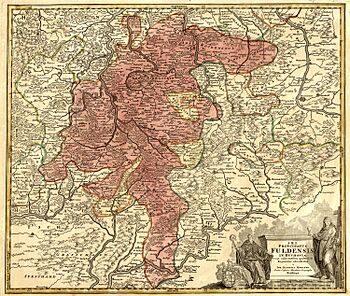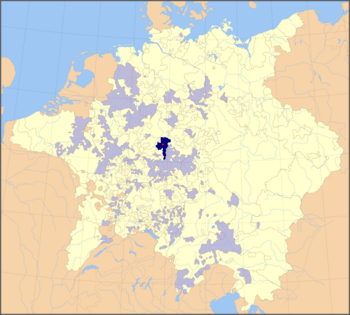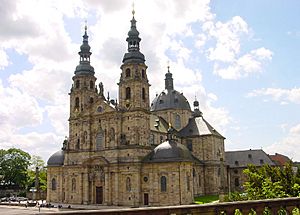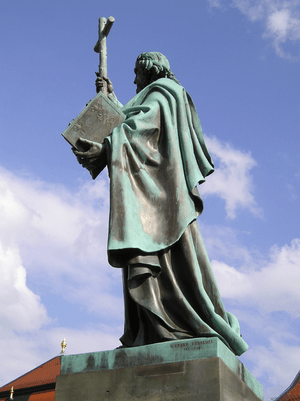Princely Abbey of Fulda facts for kids
Quick facts for kids
Princely Abbey; Prince-Bishopric of Fulda
Fürstabtei - Fürstbistum Fulda
|
|||||||||
|---|---|---|---|---|---|---|---|---|---|
| 1221–1802 | |||||||||

Territory of the Princely Abbey of Fulda in the early 18th century
|
|||||||||

Location of Fulda and its territory in the Holy Roman Empire (1648)
|
|||||||||
| Status | Princely Abbey | ||||||||
| Capital | Fulda | ||||||||
| Common languages | Hessian | ||||||||
| Government | Elective principality | ||||||||
| Historical era | Middle Ages Early modern period |
||||||||
|
• Founded
|
744 | ||||||||
|
• Imperial immediacy
|
1221 | ||||||||
|
• Joined
Upper Rhenish Circle |
1500 | ||||||||
|
• Elevated to
Prince-Bishopric |
1752 | ||||||||
|
• Mediatised to
Nassau-Orange |
1802 | ||||||||
|
|||||||||
| Today part of | Germany | ||||||||
The Abbey of Fulda was a very important Benedictine monastery in what is now Hesse, Germany. It started as a simple abbey, but over time, it grew into a powerful "princely abbey" and later a "prince-bishopric." This meant its leaders, the abbots and then prince-bishops, not only managed the church but also ruled a territory like a prince.
Fulda Abbey was founded in 744 by Saint Sturm, a student of Saint Boniface. When Boniface was buried there, Fulda became a major center for learning and religion. It was a popular place for pilgrims. The Annals of Fulda, a key historical record of the Carolingian Empire, was written here. In 1221, the abbey gained the right to rule its own land. This made its abbots powerful princes in the Holy Roman Empire. Later, in 1752, it became a prince-bishopric. The abbey was closed in 1802, but the local church still exists today.
Contents
History of Fulda Abbey
Founding and Early Growth
In the mid-700s, Saint Boniface wanted a large church built. His student, Saint Sturm, found a good spot by the Fulda River. The monastery officially began on March 12, 744. Sturm visited famous monasteries in Italy, like Monte Cassino, for ideas. Boniface was very proud of Fulda. He even got the Pope to make Fulda directly answerable to the Pope, not local bishops.
After Boniface died in 754, he was buried at Fulda. This made the abbey a very holy place and a popular destination for pilgrims. Saint Sturm became the first abbot. Under his leadership, Fulda grew quickly.
Learning and Production
The monks at Fulda were skilled in many trades. They produced many manuscripts, which helped grow the abbey's library. They also made goods that made the monastery rich. As Fulda expanded, some monks moved out to start villages. These villages focused on trade and farming but stayed connected to the monastery. Together, the monks built a large library, a strong economy, and a great center for education.
In 774, Carloman, a powerful ruler, took control of Fulda. He wanted to make sure it continued to succeed. Fulda was becoming a vital cultural center for the Carolingian Empire. Carloman believed the abbey's religious work would help his people.
The Famous School of Fulda
The school at Fulda monastery became very important under Abbot Baugulf. It had an inner school for Christian studies. There was also an outer school for other subjects, open to students who were not monks. Boniface had sent Fulda's teachers to learn from scholars in other regions. They returned with knowledge and books on science, literature, and theology. In 787, Charlemagne praised Fulda as a model school. He said it was excellent at educating people in both religious and everyday matters.
Later, under Abbot Rabanus Maurus in 822, the school became even more important. Rabanus had studied there himself. He set up different departments for sciences, theology, and arts. He also collected many holy relics and old manuscripts. This made Fulda even more significant in the Frankish Empire. Each new relic brought more gifts and power to the abbey. Rabanus believed these holy items would also bring his monks and pilgrims closer to God. Sadly, many of these treasures were lost when Fulda was looted during the Thirty Years' War.
Becoming a Principality
Over time, Fulda remained a very important place in Germany. As the Carolingian Empire weakened, Fulda had to find new supporters. For centuries, the abbot of Fulda was the main leader for all Benedictine monasteries in Germany.
From 1221, the abbots of Fulda also became "Princes of the Holy Roman Empire." Emperor Frederick II gave them this high rank. This meant they had both religious and political duties. Fulda's growing importance brought a lot of wealth. Because of this, many rich and noble people joined the abbey. By the 14th century, some wealthy monks tried to turn monastery lands into their own property. This caused problems and even a rebellion by local citizens. Balancing their duties to the empire with traditional monastic ideals became very difficult.
In later medieval times, a dean managed the school. This gave the school more independence from the abbot. However, the monastery and city never fully regained their earlier fame as a major cultural center. The monastery was finally closed in 1802. Its territory became secular, meaning it was no longer ruled by the church, in 1803. However, the local bishop's office continued to exist.
The former territory of Fulda joined the Principality of Orange-Nassau. This new state was called the Principality of Nassau-Orange-Fulda. Its leader, Prince William Frederick, refused to join the Confederation of the Rhine. After the dissolution of the Holy Roman Empire in 1806, he fled. The French then took over Fulda. In 1810, it became part of the Grand Duchy of Frankfurt. Later, Austria and Prussia controlled it. In 1815, the Congress of Vienna made it the Grand Duchy of Fulda. It was then given to the Electorate of Hesse.
Library and Scriptorium
The library at Fulda held about 2000 manuscripts. These included important works like Tacitus' Annales and Ammianus Marcellinus' Res gestae. The Codex Fuldensis, a key text for early German literature, was also kept here. It is believed that in 1417, a book-hunter found the last copy of Lucretius's De Rerum Natura here. This book later became very important for scholars. Many of Fulda's records are now in the state archives in Marburg. As of 2013, the Fulda manuscripts are spread out. Some are even in the Vatican Library.
The monks of Fulda also created the "Annales necrologici." This was a list of all abbey members who had died since Saint Sturm's death in 744. The monks would pray for those on the list to help them reach heaven. At first, it only listed Fulda members. But as Fulda grew, it included patrons, citizens, and nobles. This record helped the monks keep track of time and remember their community.
Notable Rulers
Here are some of the important leaders of Fulda Abbey:
Abbots
- Saint Sturm (744-779): The founder and first abbot.
- Baugulf (779-802): Focused on the monastery school.
- Ratgar (802-817): Known for his ambitious building projects.
- Eigil (818-822): Continued building the new church, inspired by St. Peter's in Rome.
- Rabanus Maurus (822-842): Made the school a top center for learning and collected many holy relics.
Prince-Abbots
- Konrad III. von Malkes (1221–1249): The first abbot to also be a Prince of the Holy Roman Empire.
- Cardinal Gustav Adolf (Baden) (1671–1677): A notable Prince-Abbot.
- Amand von Buseck (1737–1756): Became Prince-Bishop after 1752.
Prince-Bishops/Prince-Abbots
- Heinrich VIII. von Bibra (1759–1788): A significant Prince-Bishop.
- Adalbert von Harstall (1789–1802): The last Prince-Abbot before the abbey was dissolved. He remained bishop until 1814.








